

 | Molecular & Cellular Biomechanics |  |
DOI: 10.32604/mcb.2021.016246
ARTICLE
Analysis of the Movement Track of Top Spinning Ball and Biomechanics in the Process of Hitting Tennis Ball
Department of Physical Education, Sanjiang University, Nanjing, 210012, China
*Corresponding Author: Xia Xie. Email: sixie727137@163.com
Received: 20 February 2021; Accepted: 23 March 2021
Abstract: The aim of this study is to analyze the movement track of top spinning tennis ball and the biomechanics characteristics of tennis players. This study took ten tennis players as an example. The hitting process of the top spinning ball was captured by two PULNIX high-speed cameras. The images were processed by APAS motion analysis system. The results showed that the top spinning ball moved forward while rotating in the hitting process and showed a large attack force after rebounding from the land. In biomechanics, A and B had larger angles of upper limb joints and larger joint speed. The center of gravity was on the right. The knee joint flexed, obtained the reactive force through pedaling and stretching, and transferred the power to the racket. At the moment of hitting, the racket head speed of A and B was the largest, 18.3 m/s and 18.5 m/s, respectively. At the end of the follow-through, the shoulder and elbow angle angles of A and B were small. Larger power was provided to the racket by the rapid internal rotation. The power of hitting the ball should be increased to improve the hitting effect and speed. Corresponding guidance can be provided to players to improve their technical level.
Keywords: Tennis; top spinning ball; movement track; biomechanics; high-speed camera
With the development of the economy, sports have been paid more and more attention [1]. Tennis has a very long history of development and has been widely loved by people worldwide. Tennis is a fierce net competition, and players need to improve their competitive level through continuous training and competition. The international competitiveness of China’s tennis is weak, especially men’s tennis [2]. To further improve the level of tennis players and narrow the gap with the world, it is necessary to conduct more research on the laws and principles of various techniques, such as biomechanics and surface electromyogram signal (sEMG) [3,4]. With the development of high-speed camera technology, the research on athletes’ technical action essentials has become more and more in-depth [5]. Zhang et al. [6] compared the differences of forehand smash action between skilled and novice badminton players through the camera and found that the trunk rotation amplitude of the skilled athletes was larger, which was the reason for the higher racket speed and better smash quality. Taylor et al. [7] compared the differences between women’s basketball players and football players during landing in the high jump and found that the external rotation of the knee joint was greater and football players’ landing was more protective and could prevent Anterior Cruciate Ligament (ACL) injury. Fullenkamp et al. [8] analyzed football instep kicking and compared the differences between novice and skilled players. It was found that the range of trunk movement of skilled players was 53% larger than that of novices, and the rotation speed of trunk was 62% higher than that of novices. Therefore, the shooting speed can be improved by training the trunk rotation. Bankosz et al. [9] studied the forehand and backhand topspin of ping-pong ball. Through the analysis of 12 players, it was found that the racket speed was the highest at the moment when the racket collided with the ball. The above result can be used in the application of the top spinning ball. Through studying 50 javelin athletes, Wei et al. [10] found that the extension of the left leg was an important factor causing ligament damage in the final stage of javelin shooting and the protection of vulnerable parts should be strengthened in the process of sports. Deschamps et al. [11] compared midfoot stringing (MFS) and rearfoot stringing (RFS). Through the comparison of multi-stage foot kinematics, they found that the angle between calcaneus and midfoot was more inclined to plant flexion and the bone downward tilt and medial longitudinal arch angle were more obvious at the later stage of swing under MFS condition. Holliday et al. [12] evaluated the kinematic changes during cycling. They found that with the increase of exercise intensity, the ankle dorsiflexion and knee extension of cyclists increased by 6% to 9%, the flexion of the elbow increased by 30% and the lumbar and thoracic flexion increased by 7% under high intensity. Qu et al. [13] studied the influence of artificial turf and damping pad on the impact force in the process of landing, designed five different surfaces, and found that the artificial turf and damping pad could provide better impact attenuation when 12 athletes landed from the height that was 60 cm above the ground. In tennis, the top spinning ball is a kind of ball hitting technique that must be mastered. It has characteristics such as fast speed, high strength, high safety coefficient, and large difficulty in return. It has been widely used in the game and is an important scoring method. Therefore, it is necessary to analyze and study the top spinning ball. This study took six tennis players as subjects.
Ten tennis players from the Department of Physical Education of Sanjiang University were selected as research subjects. All of them held the racket with the right hand. They all knew the purpose and content of the experiment. They had no violent exercise 24 h before the experiment and no limb injury in the past half-year. They were able to play the top spinning ball skillfully. They have signed the informed consent. Their general information is shown in Tab. 1.

Forehand stroke is a basic skill in tennis, and its success rate has a significant impact on the result of the game [14]. Forehand topspin is a necessary scoring method, and its advantages are: (1) easy to control and master; (2) the flight arc of the ball is large, and bouncing of ball is high and powerful; (3) it is not easy to get out of boundary and is not easy to be hit by the opponent, which is conducive to direct scoring. The hitting process of the top spinning ball is as follows. The left foot is in front, and the ball comes from one side. The racket swings the whole tennis ball forward from bottom to top to drive the tennis ball to rotate from bottom to top. After hitting the ball, the center of gravity is lifted, and the racket swings over the head. This process can be divided into three stages: ① swing the racket back (Fig. 1): prepare to meet the incoming ball and swing the racket back, and the racket head is farthest from the trunk at this moment; ② swing and hit the ball (Fig. 2): swing the racket forward to touch the ball; ③ end with follow-through (Fig. 3): after hitting, the racket swings to the left shoulder, and the action ends.

Figure 1: Backswing
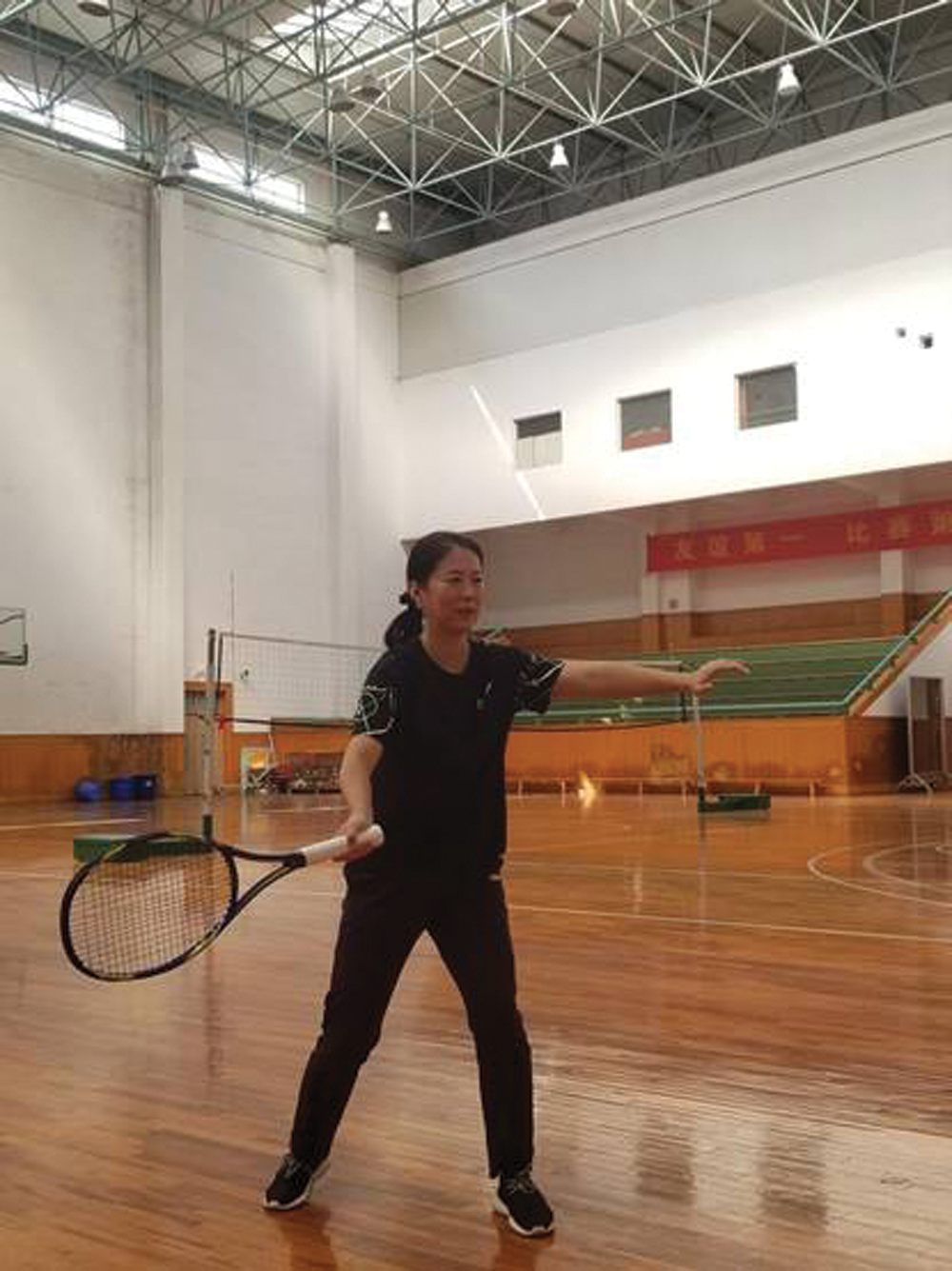
Figure 2: Swing to hit the ball
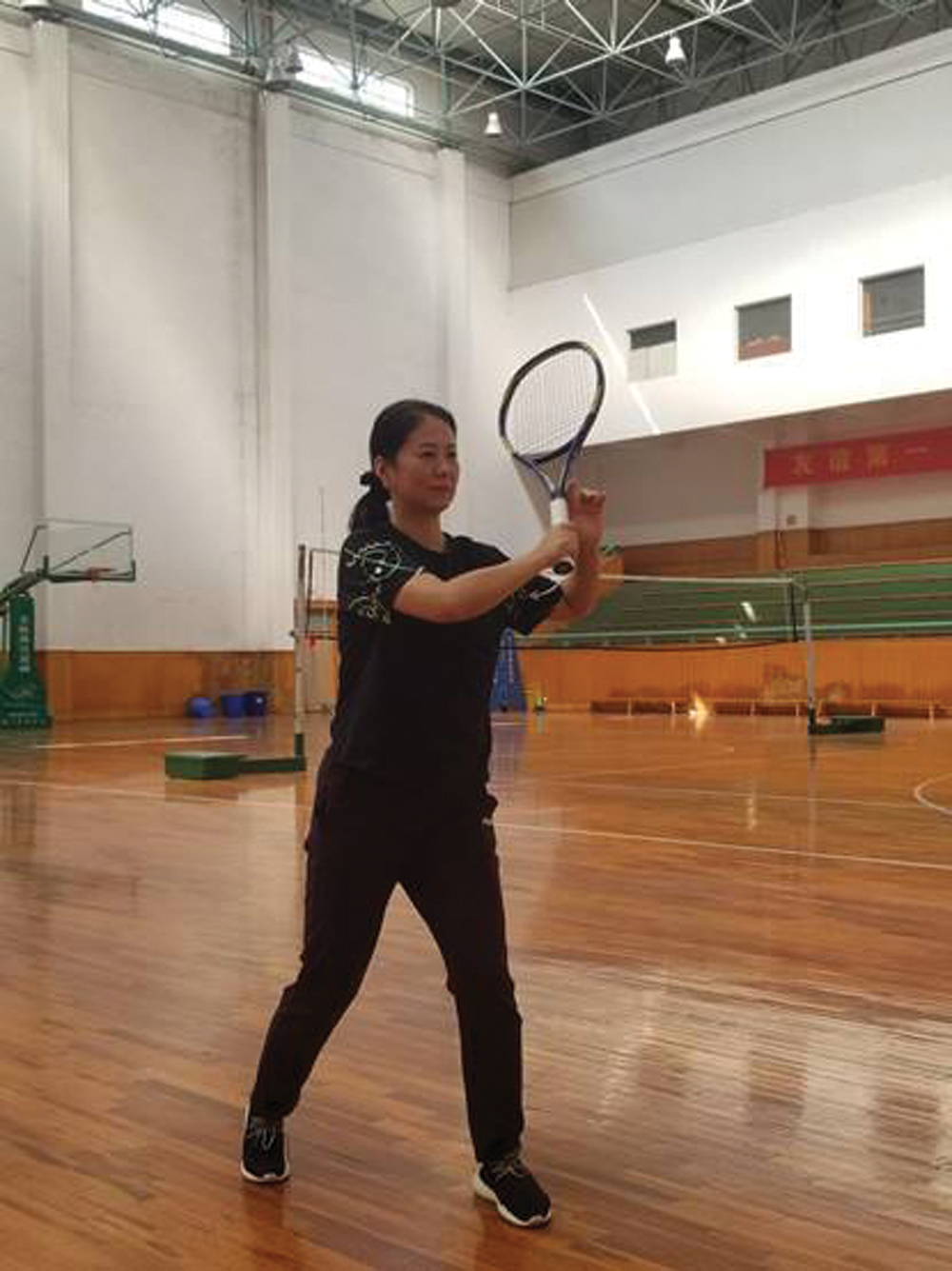
Figure 3: End with follow-through
Two PULNIX high-speed cameras were used for shooting. The experimental scene is shown in Fig. 4. One was placed on the right front side of the athlete, which was 10 m away, and the other was placed in front of the athlete’s right side, which was 10 m away. The angle between the main optical axis of the two cameras was 60°. The two cameras were connected by a synchronizer. The shooting speed was 120 frames/s. After warming up, the athletes stood in the shooting area and did the complete action once to verify whether the equipment matches. If the equipment was normal, the test started. The ball feeder fed a medium fast ball. Each player hit three top spinning balls, and then the shooting ended. In the process of hitting, the players held the racket in a semi-Western way and adopted a semi-open position. The axis parallel to the baseline was defined as the X axis, and the axis parallel to the sideline was defined as the Y axis.
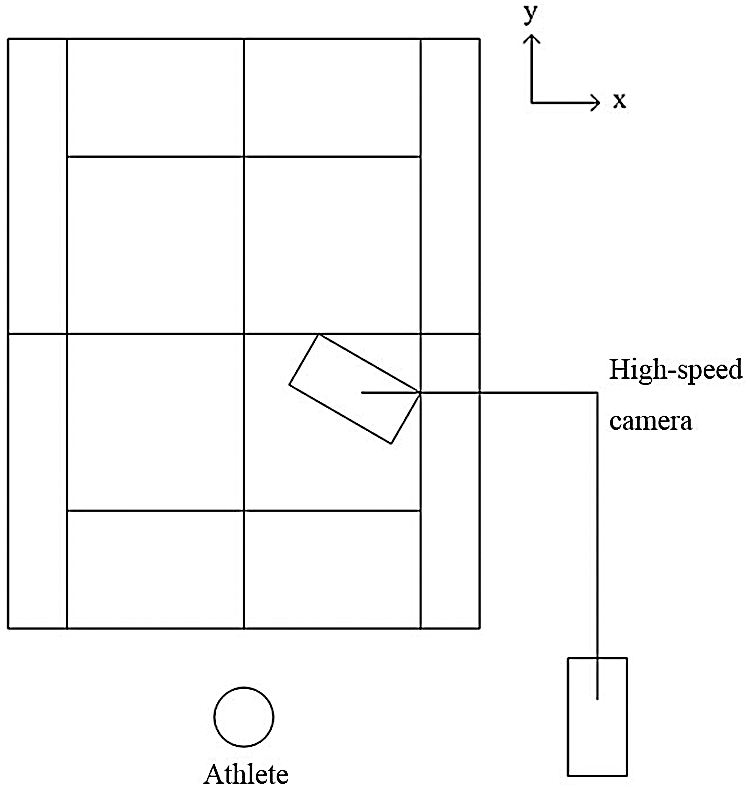
Figure 4: Experimental scenario
The image was processed using the APAS motion analysis system [15] produced by Ariel company. The Japanese human body inertia parameter model [16] was adopted. Twenty-three joint points were selected. The whole hitting process was analyzed. The collected data were recorded and calculated in Excel 2003, and graphs and tables were drawn.
3.1 Motion Track of Top Spinning Ball
The motion tracks of the racket and ball in the hitting process of top spinning ball are shown in Fig. 5. It was seen from Fig. 5 that the track of the racket was upward. The tennis ball was affected by friction and elasticity at the same time, which produced torque and turns. The tennis ball rotated and moved forward. In the process of hitting, the player transferred the rotational force to the tennis ball through the rotation of the trunk to make it fly forward while rotating. When the tennis ball landed, it jumped upward, with a great forward momentum and strong aggressiveness; therefore, returning the ball was difficult.

Figure 5: Motion track of racket and ball
3.2 Biomechanical Characteristics
At the end of the backswing, the angle and speed of the upper limb joints of the athletes are shown in Tab. 2.

It was seen from Tab. 2 that the shoulder angles of A and B were 42.3° and 41.6° respectively, the shoulder angles of C, D, E, F, G, H, I, and J were about 40°, the elbow angles of A and B were 139.6° and 132.7°, respectively, and the elbow angles of C, D, E, F, G, H, I, and J were about 120°, i.e., A and B had larger shoulder and elbow angles compared to C, D, E, F, G, H, I, and J. The right elbow speed of A and B were 2.36 m/s and 1.47 m/s, and the right wrist speed of A and B were 3.31 m/s and 2.61 m/s, respectively, which were larger than C, D, E, F, G, H, I, and J.
The changes of joint angles of lower limbs of athletes are shown in Tab. 3.

It was seen from Tab. 3 that the angles of the left knee and left hip of the athletes were greater than those of the right knee and right hip, indicating that the center of gravity of the human body was more inclined to the right. From the perspective of knee joint, the left and right knees of A were 127.3° and 110.5°, respectively, with a difference of 16.8°, those of B were 125.6° and 112.3°, respectively, with a difference of 13.3°, and the knee joint angles of C, D, E, F, G, H, I, and J were larger, with a smaller difference between the left and right knees.
The time used by the athletes in the swinging and hitting stage is shown in Fig. 6.
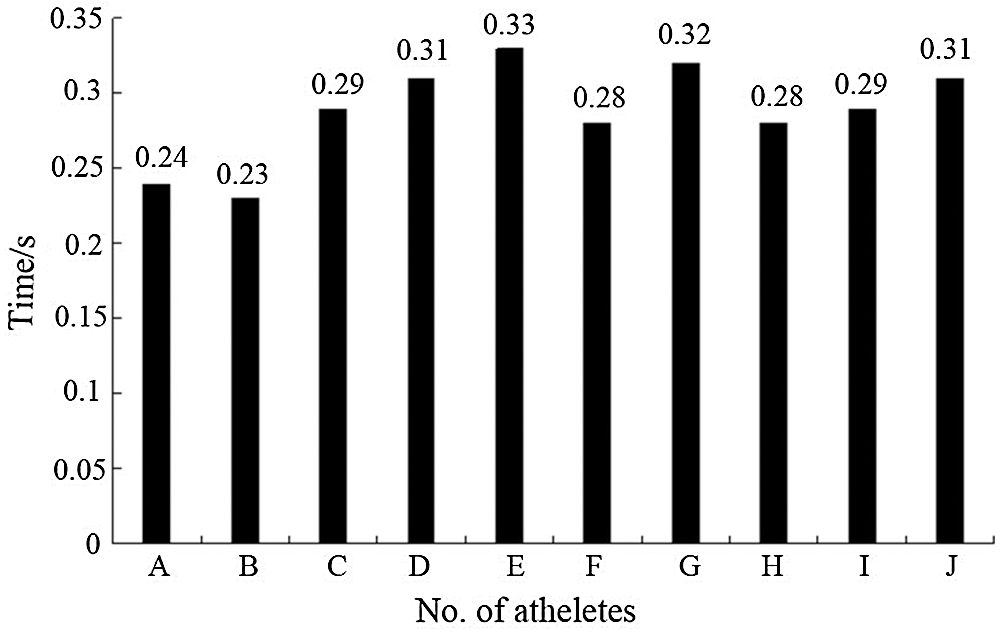
Figure 6: Time used in the stage of swinging to hit the ball
According to Fig. 6, B spent the shortest time, 0.23 s, followed by A, 0.24 s; the time spent by C, D, E, F, G, H, I, and J was more than 0.25 s, and E spent the longest time, 0.33 s. Athletes A and B had a difference with C, D, E, F, G, H, I, and J in time consumption in the stage of swinging and hitting.
At the moment of hitting, the speeds of upper limb joints and racket head are shown in Tab. 4.

It was seen from Tab. 4 that the racket head speed of A and B was the highest, which was 18.3 m/s and 18.5 m/s, respectively, while the racket head speed of C, D, E, F, G, H, I, and J was relatively low. At the moment of hitting, the speed of upper limb joints of A and B was also greater, and shoulder < elbow < wrist < racket head. Taking athlete A as an example, the speed of the shoulder, elbow, wrist, and racket head was 1.5 m/s, 4.3 m/s, 8.6 m/s, and 18.3 m/s, respectively, showing an increasing tendency, but the speed of the shoulder, elbow, and wrist of C, D, E, F, G, H, I, and J were slightly smaller than A and B, leading to a large difference in the speed of racket head.
At the moment of ending with follow-through, the angles of the right shoulder and elbow joint are shown in Fig. 7.
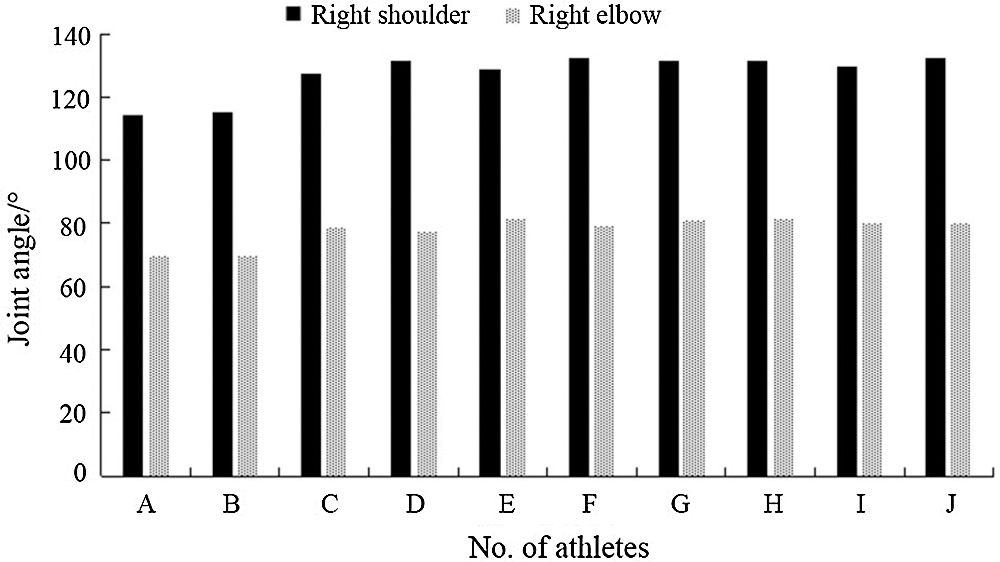
Figure 7: Angles of the right shoulder and elbow joint
According to Fig. 7, at the end of follow-through, the angle of the shoulder joint of the athletes was large, and the angle of the elbow joint was small. By comparison, the angle of the right shoulder joint of A and B was 114.3° and 115.2°, respectively, which was smaller than that of the other eight athletes, and the right elbow joint of A and B was 69.8° and 69.7°, respectively, which were also smaller than that of the other eight athletes. The angles of the right shoulder joint of C, D, E, F, G, H, I, and J were larger than 120°, and the angles of the right elbow joint was about 80°.
The reason why the top spinning ball spins up is that the racket and ball are not in direct contact in the hitting process, but there is an upward movement to make the ball spin up [17]. When a tennis ball moves in the air, assuming that it does not rotate, it shall move parallel and forward. After receiving a rotating force, the ball will produce a Magnus effect [18] to deflect its motion track. It is because the surrounding fluid also rotates in the process of rotation, and the flow velocity becomes larger on one side and smaller on the other side, forming a lateral force to change the flight direction of the object. The greater the rotation force is, the faster the ball will rotate. According to the motion track of the top spinning ball, it is found that the player should increase the hitting force, improve the speed of swing in the process of hitting, and enhance the friction between the racket and ball through lifting so that the ball can rotate quickly and move forward.
In the stage of preparation of backswing, the player turned the body sideways, drove the shoulder through the trunk, and then drove the elbow, wrist, and racket. In this process, the change of joint angles could reflect the motion range of the joints. The large angle of the upper limb joint was more conducive to obtaining a higher hitting point and increasing the accuracy of hitting the ball. It was found from the results that the joint angle and speed of A and B were larger, indicating that the backswing action of A and B had a larger movement range and the racket was farther away from the trunk; therefore, the action provided a larger momentum for hitting the ball, obtained a large linear velocity, and ensured the smoothness and extension of the action. The joint speed of the shoulder was the lowest, followed by the elbow and wrist, which conformed to the characteristic that the large joint drove the small joint. In the comparison of the lower joint angle, in the hitting process, the body center of gravity of C, D, E, F, G, H, I, and J was higher, the knee joint flexion was not enough, and the center of gravity was not right enough. The right leg of C, D, E, F, G, H, I, and J could not fully thrust against the ground and could not obtain a large reaction force to hit the ball, while A and B put the center of gravity on the right foot so that the lower limbs could pedal and stretch better.
In the stage of swinging and hitting, the player faced the ball, transferred the ground reaction force to the racket through lower limb pedaling and stretching, and quickly transferred the force on the racket head to the ball. In this stage, the greater the racket head was, the higher the ball speed was. In a short time, the trunk of A and B rotated quickly, and the lower limbs pedaled and stretched quickly and then hit the ball quickly. At that moment, the energy was fully released. In this stage, C, D, E, F, G, H, I, and J did not have enough body rotation, the time used was long, and the strength was not enough, which was not beneficial to obtain a good hitting effect. In the process of hitting, the joints accelerated in turn, and the energy was superimposed step by step and finally transmitted to the racket. However, for the last four players, the speeds of their upper limb joints were not enough, and the energy from the proximal end of the human body was not well transmitted to the distal end, which made the speed of the racket head small. In the process of hitting, the higher the speed of racket head was, the higher the speed of the ball was, the shorter the time left for the opponent to react was, and the more difficult it was to return, which was more conducive to scoring.
At the end of the follow-through, the arm rotated inward quickly, and the center of gravity moved forward. At that moment, the longer the racket acted on the ball, the greater the strength and speed of the ball were, and the more fluent the movement was. The shoulder and elbow angles of athletes C, D, E, F, G, H, I, and J were relatively large, which might lead to excessive stretching and joint rotation and increase the risk of injury [19].
Through the research, we have a clearer understanding of the movement track and biomechanical characteristics of top spinning ball, which is helpful for coaches to give targeted guidance according to the shortcomings of athletes to improve hitting effect. However, this study also has some limitations. The sample size was small, and the surface EMG characteristics were not analyzed, which will be addressed in future works.
Tennis has a history of more than 100 years, and its style and technology are constantly developing and changing. The top spinning ball is an important technology, and studying the top spinning ball can understand how to improve the effect of hitting so as to obtain better results. According to the research of this paper, it was found that in the process of hitting:
(1) the ball rotated and moved forward in the flight process and rebounded after landing, which was greatly aggressive;
(2) the speed of the upper limb joints increased gradually, and the small joint was driven by the large joint;
(3) the greater the angles of shoulder, elbow, and wrist joints were, the more sufficient the extension was, and the better the hitting effect was;
(4) in the stage of swinging to hit the ball, the shorter the time was, the better the effect was;
(5) when the velocity of the upper limb joint was high, the speed of the racket head was higher;
(6) After the end of follow-through, the angles of the shoulder and elbow joints should be controlled to avoid sports injury.
Funding Statement: The authors received no specific funding for this study.
Conflicts of Interest: The authors declare that they have no conflicts of interest to report regarding the present study.
1. Xu, C., Tian, J., Liu, C., Wang, Y. (2017). Spring is coming: WTA and tennis in China: An interview with Mr Fabrice Chouquet, director of WTA and Mr Guoqing Yi. International Journal of Sports Marketing and Sponsorship, 18(1), 106–115. [Google Scholar]
2. Tian, C. (2017). The problems and the ways of the development of competitive tennis in China. Agro Food Industry Hi Tech, 28(1), 29–32. [Google Scholar]
3. De Ste Croix, M. B. A., Priestley, A. M., Lloyd, R. S., Oliver, J. L. (2015). ACL injury risk in elite female youth soccer: Changes in neuromuscular control of the knee following soccer-specific fatigue. Scandinavian Journal of Medicine & Science in Sports, 25(5), e531–e538. [Google Scholar]
4. Vasudevan, J. M., Logan, A., Shultz, R., Koval, J. J., Roh, E. Y. et al. (2016). Comparison of muscle onset activation sequences between a Golf or Tennis swing and common training exercises using surface electromyography: A pilot study. Journal of Sports Medicine, 2016, 3987486. [Google Scholar]
5. Ijiri, T., Nakamura, A., Hirabayashi, A., Sakai, W., Miyazaki, T. et al. (2017). Automatic spin measurements for pitched Baseballs via consumer-grade high-speed cameras. Signal Image & Video Processing, 11, 1197–1204. [Google Scholar]
6. Zhang, Z., Li, S., Wan, B., Visentin, P., Jiang, Q. et al. (2016). The influence of X-factor (trunk rotation) and experience on the quality of the badminton forehand smash. Journal of Human Kinetics, 53(1), 9–22. [Google Scholar]
7. Taylor, J. B., Ford, K. R., Schmitz, R. J., Ross, S. E., Ackerman, T. A. et al. (2017). Biomechanical differences in female basketball and soccer players during multi-directional jump landings. Journal of Strength and Conditioning Research, 31(11), 1. [Google Scholar]
8. Fullenkamp, A. M., Campbell, B. M., Laurent, C. M., Lane, A. P. (2015). The contribution of trunk axial kinematics to poststrike ball velocity during maximal instep soccer kicking. Journal of Applied Biomechanics, 31(5), 370–376. [Google Scholar]
9. Bankosz, Z., Winiarski, S. (2017). The kinematics of table tennis racquet. The differences between topspin strokes. Journal of Sports Medicine and Physical Fitness, 57(3), 202–213. [Google Scholar]
10. Wang, W., Li, Y. L. (2021). Study on treatment and rehabilitation training of ligament injury of javelin throwers based on sports biomechanics. Measurement, 171(4), 108757. [Google Scholar]
11. Deschamps, K., Eerdekens, M., Peters, H., Matricali, G. A., Staes, F. (2019). Multi-segment foot kinematics during running and its association with striking patterns. Sports Biomechanics, 1–14. [Google Scholar]
12. Holliday, W., Theo, R., Fisher, J., Swart, J. (2019). Cycling: Joint kinematics and muscle activity during differing intensities. Sports Biomechanics, 2, 1–15. [Google Scholar]
13. Qu, H., Zhang, S., Sorochan, J. C., Weinhandl, J. T., Thoms, A. W. et al. (2020). Effects of synthetic turf and shock pad on impact attenuation related biomechanics during drop landing. Sports Biomechanics, 3, 1–13. [Google Scholar]
14. Kwon, S., Pfister, R., Hager, R. L., Hunter, I., Seeley, M. (2017). Influence of tennis racquet kinematics on ball topspin angular velocity and accuracy during the forehand groundstroke. Journal of Sports Science & Medicine, 16(4), 505–513. [Google Scholar]
15. Han, K. S., Shin, S. H., Yu, C. H., Kwon, T. K. (2014). Postural responses during the various frequencies of anteroposterior perturbation. Bio-Medical Materials and Engineering, 24(6), 2537–2545. [Google Scholar]
16. Matsui, H. (1958). Sports and center of gravity of the body. Xinglin Academy, Japan: Sports Science Society. [Google Scholar]
17. Cross, R., Lindsey, C. (2019). Topspin generation in tennis. Sports Engineering, 22(1). [Google Scholar]
18. Timková, V., Ješková, Z. (2017). How magnus bends the flying ball–Experimenting and modeling. Physics Teacher, 55(2), 112–114. [Google Scholar]
19. Dines, J. S., Bedi, A., Williams, P. N., Dodson, C. C., Ellenbecker, T. et al. (2015). Tennis injuries: Epidemiology, pathophysiology, and treatment. Journal of the American Academy of Orthopaedic Surgeons, 23(3), 181. [Google Scholar]
 | This work is licensed under a Creative Commons Attribution 4.0 International License, which permits unrestricted use, distribution, and reproduction in any medium, provided the original work is properly cited. |